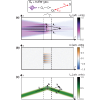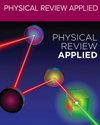气体中的光化学诱导声光技术
IF 4.4
2区 物理与天体物理
Q2 PHYSICS, APPLIED
引用次数: 0
摘要
声光技术包括在介质(通常是晶体)中发射声波,以调节其折射率并产生可调光栅。在这篇文章中,我们介绍了在气体中产生声光技术的另一种方案的理论基础。在这种方案中,声波是由空间调制紫外光的局部吸收(进而气体加热)引发的,正如 Michine 和 Yoneda [Commun. Phys.我们通过气体中存在的臭氧分子的光解离,确定了紫外线吸收所引发的化学反应,并计算了气体中温度随空间和时间而升高的结果。欧拉流体方程的求解结果表明,调制等温加热会在气体中产生混合声熵波,其高幅值密度(以及折射率)调制可用于操纵高功率激光。根据我们的计算,在室温下,只需使用几毫米含百分之几臭氧成分的气体,紫外线流量小于 100 mJ/cm2,就能获得接近 100% 的衍射效率,这与实验测量结果一致。我们的分析提出了通过改变缓冲气体成分来优化衍射效率的可行方法。气体的光学损伤阈值比固体高出 2-3 个数量级;因此,这些光学元件应该能够操纵千焦耳级激光。本文章由计算机程序翻译,如有差异,请以英文原文为准。

Photochemically induced acousto-optics in gases
Acousto-optics consists of launching acoustic waves in a medium (usually a crystal) in order to modulate its refractive index and create a tunable optical grating. In this article, we present the theoretical basis of an alternative scheme to generate acousto-optics in a gas, where the acoustic waves are initiated by the localized absorption (and thus gas heating) of spatially modulated UV light, as was demonstrated by Michine and Yoneda [Commun. Phys. 3, 24 (2020)]. We identify the chemical reactions initiated by the absorption of UV light via the photodissociation of ozone molecules present in the gas, and calculate the resulting temperature increase in the gas as a function of space and time. Solving the Euler fluid equations shows that the modulated, isochoric heating initiates a mixed acoustic-entropy wave in the gas, whose high-amplitude density (and thus refractive index) modulation can be used to manipulate a high-power laser. We calculate that diffraction efficiencies near 100% can be obtained using only a few millimeters of gas containing a few percent ozone fraction at room temperature, with UV fluences of less than 100 —consistent with the experimental measurements. Our analysis suggests possible ways to optimize the diffraction efficiency by changing the buffer gas composition. Gases have optics damage thresholds 2–3 orders of magnitude beyond those of solids; these optical elements should therefore be able to manipulate kilojoule-class lasers.
求助全文
通过发布文献求助,成功后即可免费获取论文全文。
去求助
来源期刊

Physical Review Applied
PHYSICS, APPLIED-
CiteScore
7.80
自引率
8.70%
发文量
760
审稿时长
2.5 months
期刊介绍:
Physical Review Applied (PRApplied) publishes high-quality papers that bridge the gap between engineering and physics, and between current and future technologies. PRApplied welcomes papers from both the engineering and physics communities, in academia and industry.
PRApplied focuses on topics including:
Biophysics, bioelectronics, and biomedical engineering,
Device physics,
Electronics,
Technology to harvest, store, and transmit energy, focusing on renewable energy technologies,
Geophysics and space science,
Industrial physics,
Magnetism and spintronics,
Metamaterials,
Microfluidics,
Nonlinear dynamics and pattern formation in natural or manufactured systems,
Nanoscience and nanotechnology,
Optics, optoelectronics, photonics, and photonic devices,
Quantum information processing, both algorithms and hardware,
Soft matter physics, including granular and complex fluids and active matter.
 求助内容:
求助内容: 应助结果提醒方式:
应助结果提醒方式:


